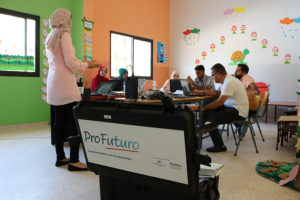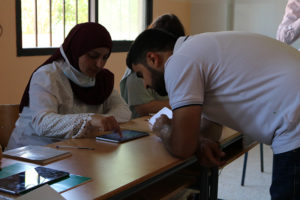Uganda, Cameroon, Kenya, Lebanon, Syria, Jordan, Palestine, Ukraine… no matter where they are, the teachers share major challenges in all the settlements in which displaced people and refugees live, including overcrowded classes, children with numerous difficulties in assimilating the learning, traumatic situations, low qualifications, a lack of support and so on.
Teaching in these contexts is not easy and the teachers face numerous challenges on top of those that already exist in vulnerable environments. The good news is that technology can help.
Digital teacher professional development programmes can provide opportunities for accessible, equitable and continuous training opportunities throughout an educator’s working life, particularly in these challenging, unstable and constantly changing contexts.
However, for the potential of these programmes to be realised, it is essential to take into account factors such as the digital and connectivity divides, the specificities of each context and the needs of the teachers themselves, among many others.

In this Observatory, we list the challenges and opportunities of technology-enabled teacher professional development programmes in refugee settings. Below we share the recommendations of the Inter-agency Network for Education in Emergencies (INEE) in its report titled Digital Teacher Professional Development in Education in Displacement (EiD) Settings. These recommendations integrate the best practices of the participants in its Quality Holistic Learning (QHL) programme, a project that seeks to increase the quality of the learning outcomes of children in humanitarian crisis contexts by means of a participatory development process that relies on the teachers as the experts who are best-placed to guide the development of high-quality holistic learning resources. These recommendations are also based on the learnings identified in the work of numerous organisations and agencies and the growing body of evidence and research in the fields of teacher professional development and humanitarian crisis contexts.
Digital teacher professional development programmes can provide opportunities for accessible, equitable and continuous training opportunities throughout an educator’s working life.

How to design and implement teacher professional development programmes that are accessible, sustainable and impactful.
- Place teachers centre stage in the training activities. Design professional development resources and events that place the teachers centre stage and take their needs, limitations and talents into account.
- Locate and contextualise. Effective educational practices are ones that are highly contextualised. Approaching each teacher professional development experience as a unique one provides the opportunity to adapt the resources and methods to the local community and thus foster local ownership of the project so as to sustain its growth and increase its impact.
- Develop digital teaching skills. Ensure that the teachers have the digital skills required for digital inclusion in their pedagogical practices. This training must be explicit and intentional, without taking anything for granted or assuming the possession of knowledge and skills.
- Pay attention to the well-being of the participants and the facilitators. Guarantee quality education in displacement, emergency, crisis and refugee contexts is a complex task. Holistic approaches that focus on well-being are important for everyone involved in these efforts. It is therefore important to integrate care for the teachers’ well-being into all the activities and components of the teacher professional development programme, ensuring that both the facilitators and the project leaders have ample opportunities to look after themselves.
- Design programmes with accessibility and connectivity in mind. It is vital to plan for online and offline use, using the Universal Design for Learning and considering the specific contexts in which the material could be used. In addition, sustainable solutions have to be identified to ensure Internet access, including data packages, Wi-Fi subscriptions, modems, devices and platforms such as the Beekee Box and Kolibri on a low-cost Raspberry Pi device, as well as simplified access to a connected IT lab. Partnerships between the public and private sectors can help to build infrastructures in the most remote and poorest regions of the world.
- Adapt the programmes to the teachers’ time constraints. Educators working in displacement and refugee settings are placed under great stress. It is therefore advisable to adapt the length and frequency of the events and tasks related to the teacher professional development to the time constraints of the teachers themselves.
- Encourage communities of practice. Develop and integrate mid and long-term peer support, coaching and mentoring components into teacher professional development programmes through communities of practice.
- Develop teacher leadership. Forming a group of leaders and instructors among the teachers will help to guarantee the sustainability, accessibility and, above all, relevance of the programmes in evolving and changing contexts. These leaders can then leverage their knowledge and assets to acquire additional skills to facilitate communities of practice and adapt or recreate learning events and resources as required.
- Collect and share progress, doubts and general feedback. Sharing progress, setbacks, doubts and innovations can serve to steer later plans and actions, collectively move the sector forward and support the health of the ecosystem.
- Collect and use real-time data and evidence. Plan ahead and integrate data collection throughout the programme’s cycle in order to assess its impact and results. This will allow simple access to the data on the efficiency of the training for the teachers and any other stakeholders to enable them to adjust and improve the programme and practices or modify the resources in keeping with the results.
- Make the teacher professional development programmes and open educational resources (OER) more visible and promote them to make them more accessible. Carefully draw up the plans for the dissemination of the training programmes and resources at different levels, sharing them via different online and offline programmes: repositories such as the iNEE website, the ProFuturo resource platform, which also has a specific model for humanitarian contexts, and the UNESCO Global Teacher Campus and platforms such as Kolibri and OpenLearn Create.
- Regularly update the materials. If the OER aren’t reviewed and updated, they lose relevance and credibility over time; the URL links are broken and new resources are not included in old and outdated documents.
- Plan the acquisition and maintenance of digital devices. Equipping the teachers with the tools and devices they need is obviously essential. This equipment should be carefully planned, taking into account that all the teachers should have equitable and consistent access to the devices.
- Promote multilingualism. Providing digital teacher professional development in the languages that the teachers are fluent in makes them feel confident in their interactions and contributions, helps them to feel empowered, fosters a sense of belonging and nurtures their ability to lead change in their schools, programmes and communities.
- Involve national, regional and local authorities and educational leaders. Engaging these stakeholders at the outset of any programme will guarantee (1) the sharing of reliable precedents and contextual information, (2) alignment with local priorities, (3) the creation of avenues for the recognition of the resulting programme’s outcomes and certifications, and (4) support for the dissemination, implementation and measurement of the resources/programmes.
- Create certifications, micro-credentials and other accreditation pathways. Providing nationally (and internationally) recognised credentials that enable the teachers to further their careers, improve their status and increase their income is a major incentive when it comes to teachers enrolling for teacher professional development programmes.
- Provide financial and non-financial incentives. In certain contexts, the teachers do not voluntarily participate in the TPD training unless there is financial compensation, which is often justified by the low salaries that they receive. It is therefore important to assign financial resources to pay the teachers a small stipend or at least compensate them for any associated costs (data packages, transport fares, etc.). In addition to the financial motivations, it is vital to acknowledge the teachers as contributors to the resources they have helped to develop and invite them to become creators of blogs, articles and other materials related to digital teacher professional development projects in order to directly share their experience, voice and authority as leaders in the education ecosystem in displacement and refugee settings.
As we have remarked on successive occasions, procuring the right high-quality technology-based training models for teachers and educators involved in formal education in the most complex and vulnerable environments can provide multiple clues for other vulnerable and less vulnerable settings. In short, getting the difficult and complex right involves extraordinary experimentation to achieve success in friendlier environments. We should therefore pay great attention to these kinds of reports and recommendations.






